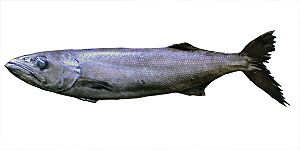Oilfish facts for kids
Quick facts for kids Oilfish |
|
|---|---|
 |
|
 |
|
| Conservation status | |
| Scientific classification | |
| Genus: |
Ruvettus
|
| Species: |
pretiosus
|
| Synonyms | |
|
List
Rovetus temminckii Cantraine, 1833
Tetragonurus simplex R. T. Lowe, 1839 Thyrsites acanthoderma R. T. Lowe, 1839 Thyrsites scholaris Poey, 1854 Ruvettus tydemani M. C. W. Weber, 1913 Ruvettus pacificus D. S. Jordan & E. K. Jordan, 1922 Ruvettus delagoensis Gilchrist & von Bonde, 1924 Ruvettus whakari Griffin, 1927 |
|

The Oilfish (Ruvettus pretiosus) is a type of snake mackerel. These fish live in oceans all over the world, especially in warm and mild areas. You can find them deep in the water, usually between 200 and 400 meters (about 650 to 1,300 feet) down. Oilfish can grow quite large, up to 3 meters (nearly 10 feet) long, though most are around 1.5 meters (5 feet). It is the only known fish in its group, or genus.
Contents
What Does an Oilfish Look Like?
Oilfish are big, torpedo-shaped fish. They often reach about 1.5 meters (5 feet) in length, but some can grow to 3 meters (10 feet). They have large, sharp teeth, rough scales, and two sets of small fins near their tail. Their bodies are usually a uniform brown color.
The meat of the Oilfish is very oily. This oil is mostly made of something called wax esters. While you can eat Oilfish, eating too much of it can act like a laxative, causing stomach upset.
Where Do Oilfish Live and What Do They Eat?
Oilfish live in tropical and temperate waters across the globe. They have been found in the Atlantic Ocean, Indian Ocean, and Pacific Ocean, including the Mediterranean Sea. They prefer deep-water areas near continental slopes and seamounts (underwater mountains). Oilfish often live alone or in pairs.
At night, if there isn't enough food on the seafloor, Oilfish will swim closer to the surface. They hunt other fish, cephalopods (like squid), and crustaceans (like crabs and shrimp). This movement is called Diel vertical migration.
Why Are Oilfish Important to Humans?
People don't usually fish for Oilfish on purpose. However, they are often caught by accident when people are fishing for Tuna or Swordfish using long fishing lines. Even though eating too much Oilfish can cause stomach problems, some restaurants sell its meat. They might call it "white-fish" because of its texture and taste.
Oilfish meat can be tasty and much cheaper than other fish. Because of this, some sellers have wrongly labeled it as Butterfish or Cod. When this happens, people might eat more than they should, not knowing about the laxative effect, and then get diarrhea.
Oilfish Labeling Issues
In January 2007, a supermarket chain in Hong Kong called ParknShop admitted to selling Oilfish that was not labeled correctly. Many people felt unwell after eating the mislabeled fish. Several complaints were made, and the Centre for Food Safety investigated the situation.
The fish were originally mislabeled in Indonesia. ParknShop stopped selling the fish. The supermarket was later fined HK$45,000 for not labeling the fish properly.
After this incident, the Centre for Food Safety in Hong Kong created new rules. These rules help make sure that Oilfish and Escolar are labeled correctly for shoppers. In 2007, the Canadian Broadcasting Corporation also reported similar cases in Canada where mislabeled Oilfish was sold in some supermarkets.
See also
- Escolar, a fish related to the Oilfish, also contains a lot of wax esters and can be mislabeled in a similar way.


